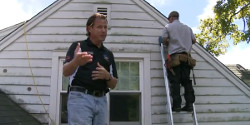Videos
Your Local Contractor is:
VeloAir Solutions
Change Location
Your Local Contractor is:
VeloAir Solutions
Change Location
In this episode of Dr. Energy Savers On the Job series, owner and founder Larry Janesky, walks us through the many solutions applied to this cape home to make it a more comfortable and energy efficient home.
This cape had poor attic insulation and serious air leakage, which increased the homeowner's energy bills and caused serious ice damming problems during the winter. To fix it, Dr. Energy Saver air sealed and insulated the attic space to prevent further ice damming and improve the overall home comfort.

A problem that this homeowner used to have was ice damming. During the winter, snow on the roof melts (from a poorly insulated & air sealed attic), forming a ridge of ice at the eaves and trapping new melted water to leak into the house.
The water damage to the attic and living area raised both health and mold concerns.
The problem was so significant that during an especially heavy winter storm in the previous year, the homeowner had to climb on the roof and manually break the large ice ridges to keep water from pouring down his kitchen cabinets!

This home is inadequately insulated, much like many homes throughout America, leading to comfort problems indoors and exterior ice damming. With old and leaky fiberglass batts installed in this attic space, large amounts of conditioned air continuously escapes from the living space and warms the roof.
First, to fix this problem, Dr. Energy Saver air seals the leaky portions of the attic to prevent conditioned air from further escaping into unwanted areas. Once the air sealing is done, 17 inches of loose-fill cellulose insulation will be sprayed across the attic floor to comply with the current Department of Energy recommendations.
In this attic, the yellow fiberglass batts have dirt stains on their bottom portion because the conditioned air is leaking from below, the insulation is acting as a filter - sifting the dust particles that come through along with the air.

Part of air sealing and insulating the attic is making sure that all the vents (including bath fans) are properly vented to the outside of the home. Attics that exhaust air from vents and bath fans into the home as opposed to outside the home, may lead to problems such as: condensation, mold, rot and even ice damming in the winter.
The bathroom fans that were originally venting into this attic space were fitted with ducts to properly vent to the outside, thus preventing unwanted air moisture from leaking into the attic space.

Cape style homes, similar to this one, usually have a knee wall space. The knee wall space is a small space created at the angle between the roof and the floor. A knee wall is usually a big source of energy waste. We're going to insulate the rafter bay so that cellulose doesn't just fall into the knee wall space when we insulate the attic.
The next step was to insulate and air seal the knee wall using a special type of rigid foam board insulation called SilverGlo™ , which is lined with a radiant barrier to help conserve heat.
Rats, squirrels, raccoons, bees, or even birds may inhabit your attic space, if they can find an opening such as a gable end vent. This home had what seemed to be nesting ground of a squirrel or smaller animal leaving quite a mess, a durable screen cover is placed over the vent to prevent this activity. Dr. Energy Saver can vacuum your attic out, removing all the insulation and animal droppings out for a clean and fresh start.

The last step is to insulate this attic, Dr. Energy Saver chose to use TruSoft™ cellulose insulation for this attic. Cellulose insulation is basically recycled newspaper that's treated with the mineral borate and a fire retardant. These two added treatments added to cellulose prevent pest infestation, mold growth, and the fire retardant gives the material an excellent fire safety rating. Cellulose insulation is denser than blown fiberglass and has a higher R-Value of 3.7 per inch.
A layer of 17 inches was blown into this attic, with special attention to rafter bays and small cavities created by typical cape style architectural features.

This cape is now ready for winter. The insulation is a warm blanket covering the entire top of this house. After the insulation is installed we contain the loose insulation with a plywood dam and install a weather-stripped and air-sealed door for maximum savings and functionality.
The homeowner now has a more comfortable house, and his energy bills are much lower than he could have ever imagined. To learn more about ways to save energy in your home, stay tuned for more episodes of Dr. Energy Saver's On the Job series, or contact your local Dr. Energy Saver today!
Areas Served